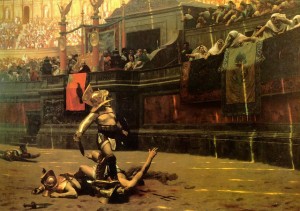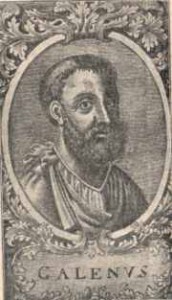Guest Blog by SASMA President –
Dr Glen Hagemann

Two weeks ago I attended the FIMS World Congress of Sports Medicine in Rome. I particularly enjoyed visiting the Colosseum and learning about the Roman gladiators, whose similarity to modern professional rugby players became more and more evident the longer I spent there! The Colosseum had a capacity of around 50,000, similar to that of our local rugby stadium , Kings Park, and the gladiators fought about three to five times every year (unlike our professional players who are expected to put their bodies on the line virtually every weekend). However, considering that the implication of losing a fight was potential death, this number of appearances was probably more than enough!
Contrary to popular belief, however, gladiators did not deliberately fight to the end. When a gladiator lost a fight, the crowd was encouraged to demonstrate whether he lived or died, but the final decision was left to the emperor; lives were often preserved as gladiators were considered valuable assets, just as our professional sportsmen are today. Seriously wounded gladiators, however, were killed by a hammer-wielding executioner (just picture the scene at the end of a Super 15 game…). Despite their value as athletes, gladiators were generally considered second rate citizens and had few if any social privileges. However, the most successful fighters were treated like modern day sporting celebrities. These trained gladiators also joined formal associations, called collegia (just like the South African Rugby Players Association) to ensure that they were provided with proper burials and that adequate compensation was given to their families.
Like the Lambies’ and the Carters’ of the world today, gladiators were often the object of female adoration. Only attractive men would be recruited as the spectators enjoyed good looking gladiators.
Gladiatorial combat was as much a science as modern rugby. Training involved the learning of a series of figures, which were broken down into various phases. Sometimes fans complained that a gladiator fought too mechanically, according to the numbers, something akin to rugby players being “over-coached” today.
 Because of their value, gladiators were looked after by only the best doctors. The most famous of these was Aelius Galenus (Galen), the forefather of sports medicine. Galen learnt the importance of diet, fitness, hygiene and preventive measures. He became a master of living anatomy, and the treatment of fractures and severe trauma, referring to wounds as “windows into the body”. His meticulous attention to gladiators’ wounds resulted in a significant reduction in their mortality rate when compared to his predecessor. In spite of this, he argued strongly against the immoderate lifestyle of athletes and their obsession with victory, which he believed was “unhealthy and potentially dangerous behaviour” (a bit unfair considering the consequences for the defeated gladiator!). He was probably the most accomplished medical researcher of the Roman period and he later became the personal physician to Emperor Marcus Aurelius. His theories dominated and influenced Western medical science for over 1500 years.
Because of their value, gladiators were looked after by only the best doctors. The most famous of these was Aelius Galenus (Galen), the forefather of sports medicine. Galen learnt the importance of diet, fitness, hygiene and preventive measures. He became a master of living anatomy, and the treatment of fractures and severe trauma, referring to wounds as “windows into the body”. His meticulous attention to gladiators’ wounds resulted in a significant reduction in their mortality rate when compared to his predecessor. In spite of this, he argued strongly against the immoderate lifestyle of athletes and their obsession with victory, which he believed was “unhealthy and potentially dangerous behaviour” (a bit unfair considering the consequences for the defeated gladiator!). He was probably the most accomplished medical researcher of the Roman period and he later became the personal physician to Emperor Marcus Aurelius. His theories dominated and influenced Western medical science for over 1500 years.
The rest of the medical team included the equivalent of modern day physiotherapists, and the Romans understood the role of sports massage in improving recovery after bouts. Like today, gladiators were placed on high carbohydrate diets and consumed their own type of isotonic sports drink in the form of a foul-smelling bone- ash solution which may even have been a kind of primitive painkiller.
************************************************************
Dr Glen Hagemann is President of the South African Sports Medicine Association (SASMA). SAMSA is a BJSM member society. The next SASMA congress will take place in October of 2013. Watch for the special SASMA issue of BJSM in July of 2013. (The 2011 SASMA issue won first prize in the BJSM cover competition for 2011)